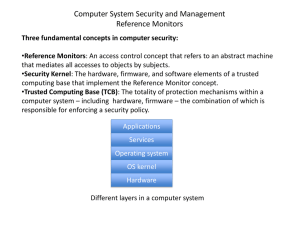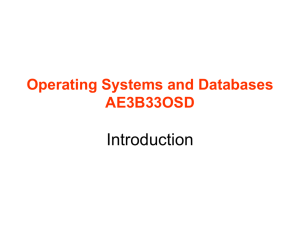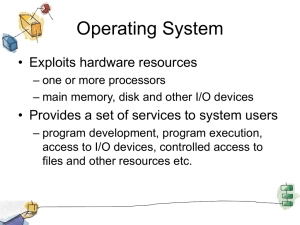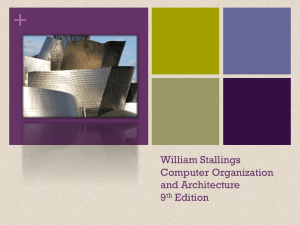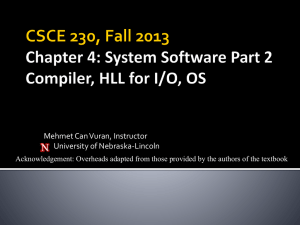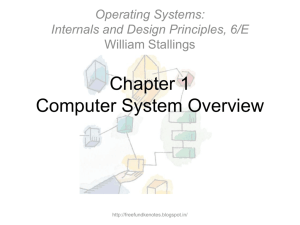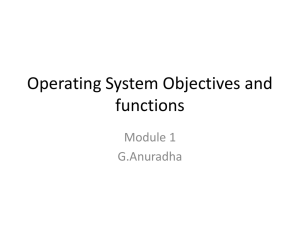Computer System Overview
advertisement
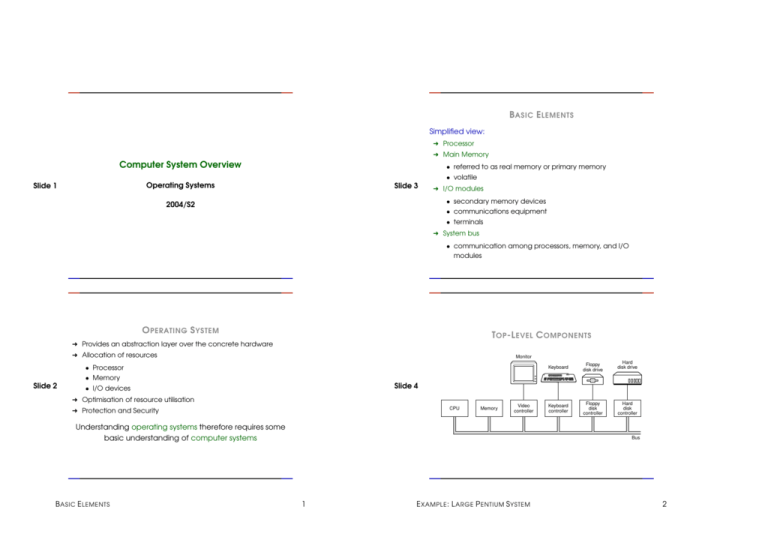
B ASIC E LEMENTS Simplified view: ➜ Processor ➜ Main Memory Computer System Overview • referred to as real memory or primary memory • volatile Operating Systems Slide 1 Slide 3 ➜ I/O modules • secondary memory devices 2004/S2 • communications equipment • terminals ➜ System bus • communication among processors, memory, and I/O modules O PERATING S YSTEM T OP -L EVEL C OMPONENTS ➜ Provides an abstraction layer over the concrete hardware ➜ Allocation of resources Monitor • Processor Keyboard Floppy disk drive Hard disk drive Keyboard controller Floppy disk controller Hard disk controller • Memory Slide 2 Slide 4 • I/O devices ➜ Optimisation of resource utilisation CPU ➜ Protection and Security Memory Video controller Understanding operating systems therefore requires some basic understanding of computer systems B ASIC E LEMENTS Bus 1 E XAMPLE : L ARGE P ENTIUM S YSTEM 2 E XAMPLE : L ARGE P ENTIUM S YSTEM Local bus Cache bus Level 2 cache P ROCESSOR R EGISTERS Memory bus PCI bridge CPU ➜ Data and address registers Main memory • Hold operands of most native machine instructions • Enable programmer to minimize main-memory references by optimizing register use PCI bus Slide 5 Slide 7 SCSI USB Mouse ISA bridge IDE disk Graphics adaptor Available PCI slot • Used by processor to control operating of the processor Monitor Keyboard • user-visible ➜ Control and status registers • Used by operating-system routines to control the execution of programs ISA bus • Sometimes not accessible by user (architecture dependent) Modem Sound card Printer Available ISA slot U SER -V ISIBLE R EGISTERS P ROCESSOR ➜ Fetches intructions from memory, decodes and executes them ➜ May be referenced by machine language instructions ➜ Set of instructions is processor specific ➜ Available to all programs - application programs and system programs ➜ Instructions include: Slide 6 ➜ Types of registers ✱ load value from memory into register Slide 8 ✱ combine operands from registers or memory • Address ✱ branch – Index – Segment pointer – Stack pointer ➜ All CPU’s have registers to store ✱ key variables and temporary results ✱ information related to control program execution P ROCESSOR R EGISTERS • Data • Many architectures do not distinguish different types 3 C ONTROL AND S TATUS R EGISTERS 4 I NSTRUCTION F ETCH C ONTROL AND S TATUS R EGISTERS E XECUTE ➜ Program counter (PC) holds address of the instruction to be fetched next ➜ Program Counter (PC) ➜ The processor fetches the instruction from memory • Contains the address of an instruction to be fetched ➜ Program counter is incremented after each fetch ➜ Instruction Register (IR) Slide 9 AND Slide 11 • Contains the instruction most recently fetched ➜ Overlapped on modern architectures (pipelining) ➜ Processor Status Word (PSW) Fetch Cycle Execute Cycle Fetch Next Instruction Execute Instruction • condition codes • interrupt enable/disable START • supervisor/user mode HALT I NSTRUCTION R EGISTER C ONTROL AND ➜ Fetched instruction is placed in the instruction register S TATUS R EGISTERS ➜ Types of instructions ➜ Condition Codes or Flags • Processor-memory • Bits set by the processor hardware as a result of operations Slide 10 – transfer data between processor and memory • Can be accessed by a program but not altered Slide 12 • Examples • Processor-I/O – data transferred to or from a peripheral device – positive/negative result – zero – overflow • Data processing – arithmetic or logic operation on data • Control – alter sequence of execution I NSTRUCTION F ETCH AND E XECUTE 5 I NTERACTION BETWEEN P ROCESSOR AND I/O D EVICES 6 I NTERRUPT C YCLE ➀ Fetch next instruction ➁ Execute instruction I NTERACTION BETWEEN P ROCESSOR AND I/O D EVICES ➂ Check for interrupt ➃ If no interrupts, fetch the next instruction ➜ CPU much faster than I/O devices ➄ If an interrupt is pending, divert to the interrupt handler - waiting for I/O operation to finish is inefficient Slide 13 Slide 15 - not feasible for mouse, keyboard Fetch Cycle ➜ I/O module sends an interrupt to CPU to signal completion Execute Cycle Interrupt Cycle Interrupts Disabled ➜ Interrupts normal sequence of execution START ➜ Interrupts are also used to signal other events Fetch Next Instruction Execute Instruction Check for Interrupt; Interrupts Process Interrupt Enabled HALT C LASSES OF I NTERRUPTS ➜ Asynchronous (external) events • I/O I NTERRUPT H ANDLER • Timer • Hardware failure Slide 14 Slide 16 ➜ Synchronous interrupts or program exceptions caused by program execution: ➜ A program that determines nature of the interrupt and performs whatever actions are needed ➜ Control is transferred to this program by the hardware ➜ Generally part of the operating system • arithmetic overflow • division by zero • execute illegal instruction • reference outside user’s memory space I NTERRUPT C YCLE 7 C ONTROL F LOW W ITH AND W ITHOUT I NTERRUPTS 8 C ONTROL F LOW W ITH User Program I/O Program 4 1 I/O Command WRITE AND User Program W ITHOUT I NTERRUPTS I/O Program 4 1 WRITE I/O Command User Program I/O Program 4 1 M ULTIPLE I NTERRUPTS I/O Command WRITE 5 Sequential Order: 2a END Slide 17 2 * 2b WRITE 2 5 WRITE Slide 19 Interrupt Handler Interrupt Handler ➜ Interrupts remain pending until the processor enables interrupts 5 WRITE ➜ After interrupt handler routine completes, the processor checks for additional interrupts END END 3a * 3 ➜ Disable interrupts so processor can complete task 3 3b WRITE WRITE (a) No interrupts WRITE (c) Interrupts; long I/O wait (b) Interrupts; short I/O wait M ULTIPLE I NTERRUPTS User Program Slide 18 ➜ Interrupt X occurs ➜ CPU disables all interrupts (only those with lower priority) ➜ Interrupt handler may enable interrupts ➜ Interrupt Y occurs ➜ Sequential or nested interrupt handling Interrupt Handler X M ULTIPLE I NTERRUPTS Interrupt Handler Y Priorities: Slide 20 (a) Sequential interrupt processing User Program ➜ Higher priority interrupts cause lower-priority interrupts to wait ➜ Causes a lower-priority interrupt handler to be interrupted Interrupt Handler X ➜ Example: when input arrives from communication line, it needs to be absorbed quickly to make room for more input Interrupt Handler Y (b) Nested interrupt processing M ULTIPLE I NTERRUPTS 9 M EMORY 10 M EMORY G OING D OWN Sould be ➜ fast H IERARCHY ➜ Decreasing cost per bit ➜ abundant Slide 21 THE ➜ Increasing capacity ➜ cheap Slide 23 ➜ Increasing access time ➜ Decreasing frequency of access of the memory by the processor Unfortunately, that’s not the reality... Solution: Locality of reference is essential! • combination of fast & expensive and slow & cheap memory M EMORY H IERARCHY D ISK CACHE Typical access time Slide 22 1 nsec Registers 2 nsec Cache 10 nsec Main memory 64-512 MB 10 msec Magnetic disk 5-50 GB Magnetic tape 20-100 GB 100 sec G OING D OWN THE H IERARCHY ➜ A portion of main memory used as a buffer to temporarily to hold data for the disk Typical capacity <1 KB Slide 24 1 MB ➜ Disk writes are clustered ➜ Some data written out may be referenced again. The data are retrieved rapidly from the software cache instead of slowly from disk ➜ Mostly transparent to operating system 11 CACHE M EMORY 12 CACHE M EMORY CACHE D ESIGN Block Transfer ➜ Cache size Word Transfer • small caches have a significant impact on performance ➜ Line size (block size) CPU Main Memory Cache Slide 25 Slide 27 • the unit of data exchanged between cache and main memory • hit means the information was found in the cache ➜ Contains a portion of main memory • larger line size ⇒ higher hit rate until probability of using newly fetched data becomes less than the probability of reusing data that has been moved out of cache ➜ Processor first checks cache ➜ If not found in cache, the block of memory containing the needed information is moved to the cache replacing some other data CACHE D ESIGN CACHE /M AIN M EMORY S YSTEM Line Number Tag 0 1 2 Block ¥ ¥ ¥ ➜ Mapping function Memory address 0 1 2 3 • determines which cache location the data will occupy Block (K words) ➜ Replacement algorithm • determines which line to replace C—1 Slide 26 Block Length (K Words) Slide 28 ¥ ¥ ¥ (a) Cache • Least-Recently-Used (LRU) algorithm ➜ Write policy • When the memory write operation takes place • Can occur every time line is updated (write-through policy) Block • Can occur only when line is replaced (write-back policy) 2n — 1 – Minimizes memory operations – Leaves memory in an obsolete state Word Length (b) Main memory CACHE D ESIGN 13 I NTERACTION BETWEEN I/O D EVICES AND P ROCESSOR 14 I NTERACTION BETWEEN I/O D EVICES AND P ROCESSOR I NTERRUPT-D RIVEN I/O ➜ Controller (chip or set of chips) provides a simple interface to OS - often, embedded OS running on the controller Slide 29 ➜ Software that communicates with controller is called device driver Slide 31 ➜ Most drivers run in kernel mode ➜ To put new driver into kernel, system may have to - be relinked - be rebooted - dynamically load new driver Issue Read command to I/O module CPU → I/O Do something else Read status of I/O module I/O → CPU Interrupt Check status ➜ Processor is interrupted when I/O module ready to exchange data ➜ Processor is free to do other work ➜ No needless waiting ➜ Consumes a lot of processor time because every word read or written passes through the processor Error condition Ready No Read word from I/O Module I/O → CPU Write word into memory CPU → memory Done? Yes Next instruction (b) Interrupt-driven I/O P ROGRAMMED I/O (P OLLING ) Slide 30 ➜ I/O module performs the action, not the processor ➜ Sets appropriate bits in the I/O status register ➜ No interrupts occur ➜ Processor checks status until operation is complete Issue Read command to I/O module CPU → I/O Read status of I/O module I/O → CPU D IRECT M EMORY ACCESS Not ready Check status Error condition Ready Read word from I/O Module I/O → CPU Write word into memory CPU → memory Slide 32 • Wastes CPU cycles No ➜ Transfers a block of data directly to or from memory ➜ An interrupt is sent when the task is complete ➜ The processor is only involved at the beginning and end of the transfer CPU → DMA Issue Read Do something block command to I/O module else Read status of DMA module Interrupt DMA → CPU Next instruction Done? Yes Next instruction (a) Programmed I/O I NTERRUPT-D RIVEN I/O 15 D IRECT M EMORY ACCESS 16


